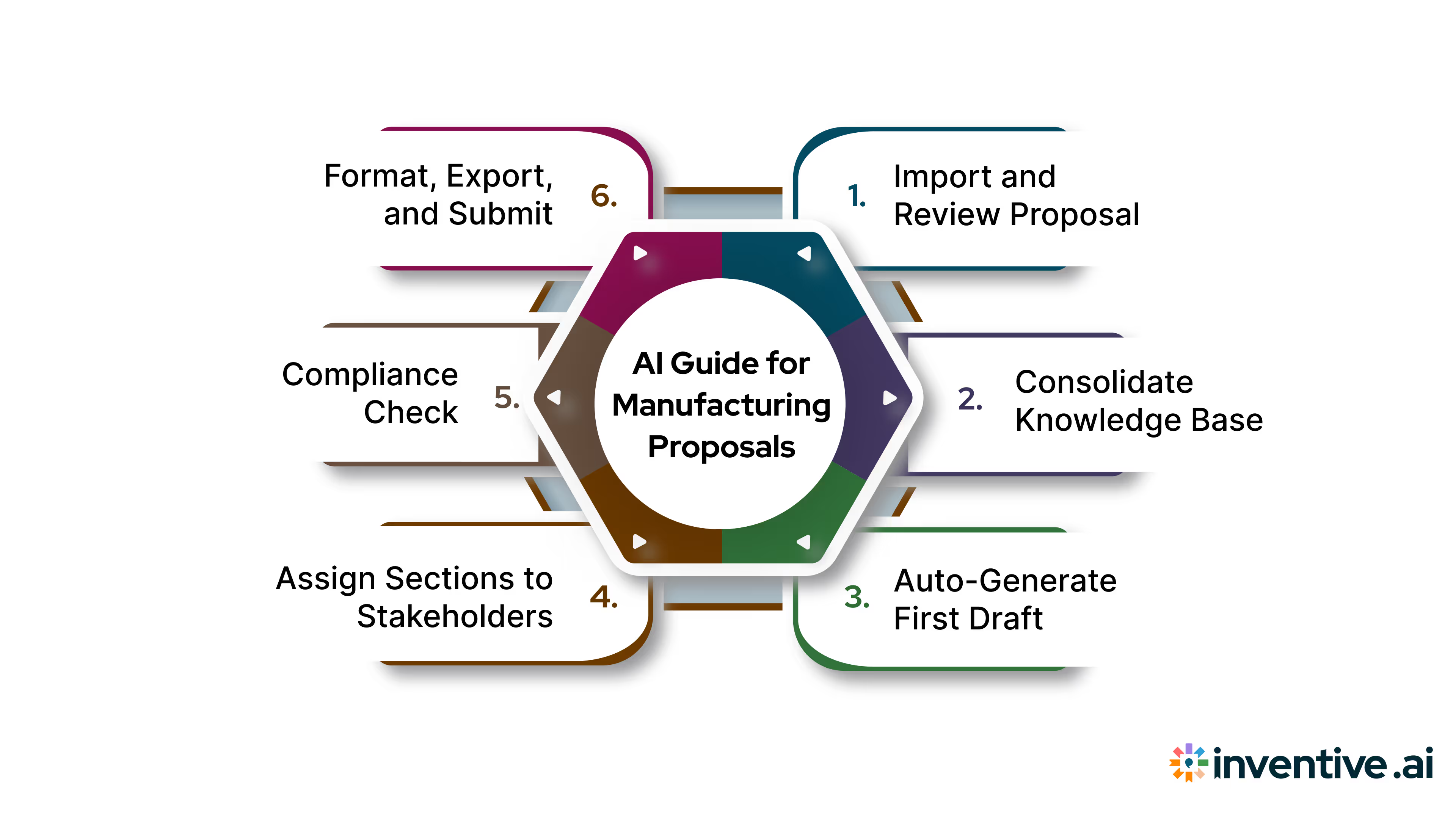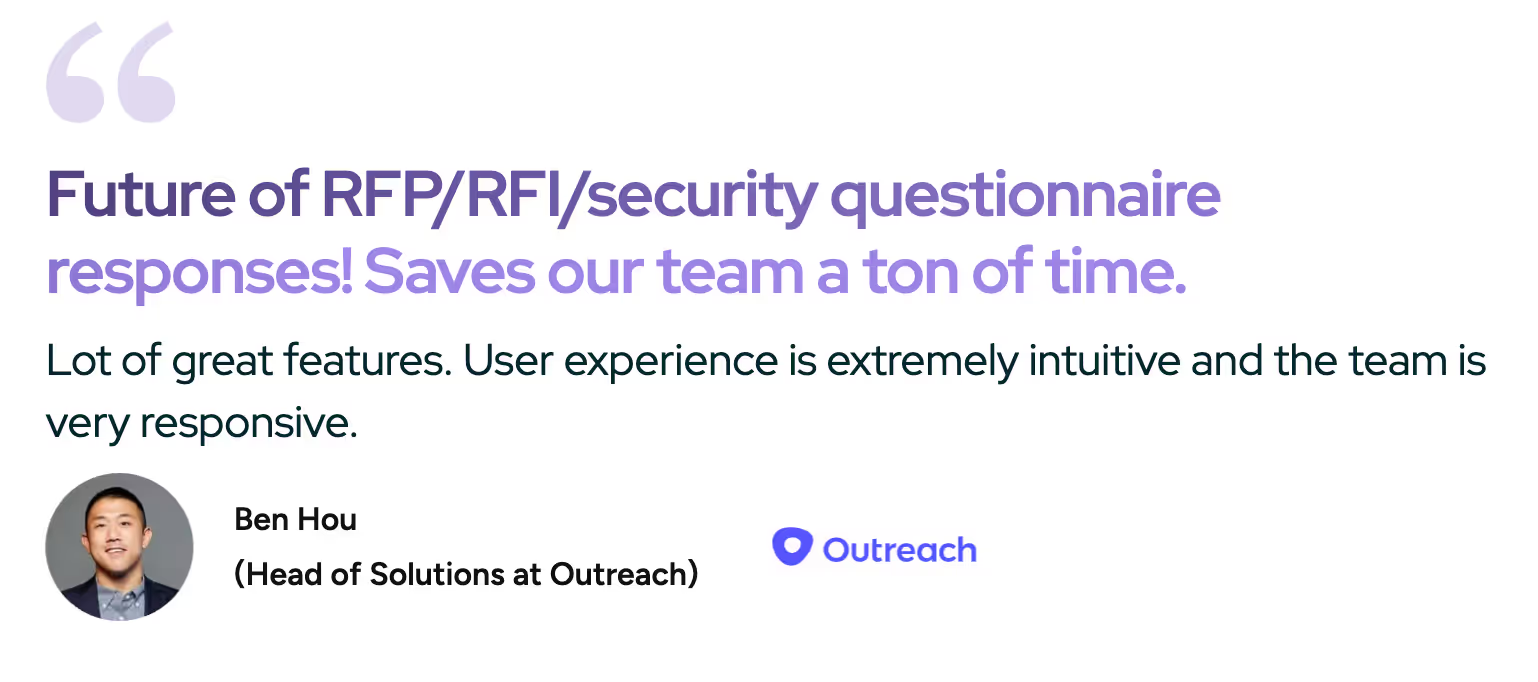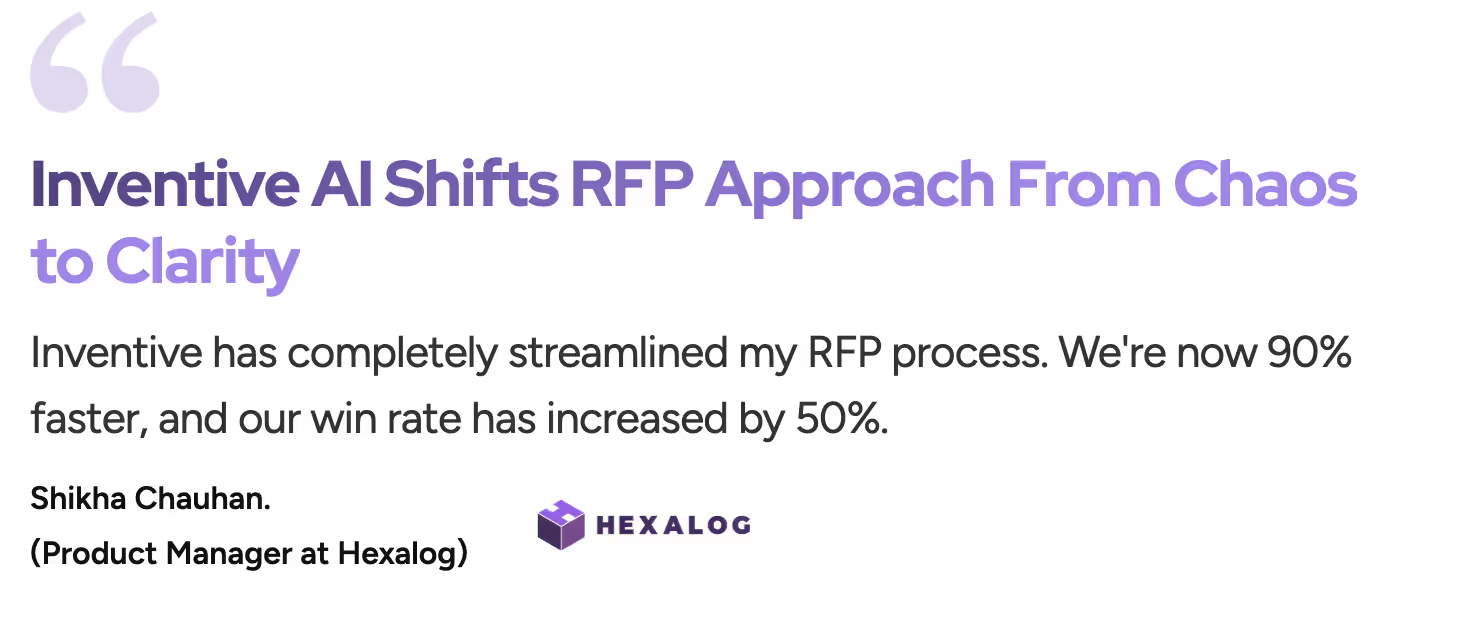How to Use AI for Manufacturing Proposal Writing?
Speed up proposal writing with AI! Automate drafts, enhance accuracy, streamline tasks, and create impressive visuals for manufacturing. Click to learn more.

Introduction
Writing proposals in the manufacturing industry involves navigating complex product specifications, supply chain details, and compliance with regulations, all while balancing cost and timelines under pressure from multiple RFPs with tight deadlines.
Rising demands require speed and accuracy, creating bottlenecks when drafting, organizing, and reviewing proposals manually. AI can alleviate these challenges by automating repetitive tasks, enhancing accuracy, and ensuring consistency
In fact, 64% of companies use Gen AI for document/proposal writing and editing.
In this blog, we’ll show you how tools can streamline your manufacturing proposal process, from drafting responses to organizing product details and ensuring technical accuracy. You can save time, reduce errors, and keep your team focused on strategic tasks, not just filling out forms.
TL;DR
- Manufacturing proposals are complex, demanding technical accuracy, regulatory compliance, and fast turnaround.
- Traditional workflows are slow and prone to errors due to siloed departments.
- AI streamlines the process by automating content generation, managing workflows, and enforcing formatting.
- While centralized knowledge bases and real-time tracking enable teams to respond to more RFPs with greater precision and higher win rates.
Why Are Manufacturing Proposals So Time-Consuming?
In the manufacturing sector, writing proposals isn’t just an administrative task, it’s an operational challenge that spans engineering, compliance, and sales strategy. A typical proposal must convey not only your ability to deliver products but your capacity to meet precise technical standards, regulatory demands, and delivery commitments, all under tight deadlines.
Several core factors make the process resource-intensive:
1. Deep Technical Complexity
Manufacturing proposals often include product specs, CAD drawings, Bills of Materials (BOM), tolerances, production methods, and certification references (e.g., ISO 9001, AS9100, RoHS). This data is spread across ERP, PLM, and local file systems, requiring significant time just to locate and validate the right versions.
2. High-Stakes Cross-Functional Input
Proposals need contributions from engineering, procurement, compliance, finance, and legal, each with unique documentation or review needs. A delay in one area (e.g., quality assurance certification validation) can stall the entire submission. Without structured workflows, teams lose time navigating silos and version chaos.
3. Recurring Content with Minor Variations
Despite technical similarities across RFPs, such as capacity planning, lead times, warranty terms, or material specs, teams often rewrite content due to a lack of centralized, reusable knowledge. This leads to inefficiencies, inconsistent messaging, and increased risk of non-compliance.
4. Rigorous Formatting and Compliance Standards
Clients, especially in automotive, aerospace, or defense sectors, often demand proposals that meet strict formatting rules (e.g., Excel templates, portal uploads, redlining policies). Failure to comply can result in disqualification, even if your bid is competitive on price and quality.
5. Compressed Timelines and High Opportunity Costs
Many RFPs arrive with submission windows of less than 10 days. Under pressure, proposal teams must deliver fully vetted, technically sound documents that align with both internal approval chains and external specs. Delays or errors not only jeopardize the current bid but can damage credibility with procurement teams.
With these challenges in mind, it’s clear that a strong proposal isn’t just about speed—it’s about structure. So, what exactly should a comprehensive manufacturing proposal contain?
What Should be Included in a Manufacturing Proposal?
A manufacturing proposal is more than just a quote, it’s a strategic document that must assure buyers of your technical capability, regulatory compliance, production feasibility, and pricing transparency. Especially when responding to RFPs or RFIs, each section must align with the client’s requirements while showcasing your strengths clearly and accurately.
Here’s what a high-quality manufacturing proposal should typically include:
1. Executive Summary
This is your first impression. It should briefly summarize what you’re offering, why your solution fits the buyer’s needs, and any standout capabilities, like expedited lead times, industry certifications, or engineering expertise.
Example:
For a client requesting custom injection-molded parts, your summary might emphasize your ISO 13485 certification for medical-grade plastics and a proven ability to deliver 5,000+ units per month.
2. Company Overview and Experience
Outline your company’s background, mission, industry experience, and relevant credentials. This builds credibility and shows you understand the industry context.
What to include:
- Years in business
- Client portfolio (anonymized if needed)
- Industry-specific knowledge (e.g., automotive, aerospace, electronics)
3. Technical Specifications of Products or Services
This is the heart of the proposal. Include:
- Product dimensions and tolerances
- Bill of Materials (BOM)
- CAD or engineering drawings
- Material descriptions (with datasheets if required)
- Product certifications (e.g., RoHS, REACH, CE, UL)
Example:
If you’re quoting for a sheet metal fabrication project, provide specific specs like gauge thickness, finishing processes (powder coating, anodizing), and material strength ratings.
4. Production Capabilities and Timeline
Clearly state your manufacturing capacity, production lead time, and any scalable options. Buyers want to know if you can meet demand now and in the future.
Include:
- Minimum order quantity (MOQ)
- Maximum production capacity per month/quarter
- Estimated production and delivery timeline
5. Quality Assurance and Compliance
Demonstrate how you meet quality standards and regulatory requirements. This section is crucial for sectors like aerospace, defense, or medical devices.
Example elements:
- ISO 9001, AS9100, or FDA certifications
- Quality control procedures (e.g., in-line inspections, FAI reports)
- Traceability systems (e.g., barcoding, serialized parts)
6. Pricing Breakdown
Offer a detailed and transparent cost structure. Avoid just a single total price, buyers want to see how costs are allocated.
Structure it as:
- Unit price by volume tier
- Tooling or setup fees (if applicable)
- Packaging and shipping costs
- Warranty terms (duration, coverage, exclusions)
7. Logistics and Delivery Terms
Outline your delivery process, shipping options, and terms (Incoterms). Global buyers especially want to know how you handle customs, duties, and freight coordination.
Example:
Include whether you offer FOB or DDP shipping, and name your freight partners or 3PL providers if relevant.
8. Risk Mitigation and Contingency Plans
This shows foresight. Explain how you manage supply chain disruptions, material shortages, or production delays.
What to mention:
- Dual sourcing strategies
- Inventory buffer capabilities
- Alternate production facilities (if any)
9. Legal and Commercial Terms
Always include your standard terms and conditions or contract boilerplate. Buyers need to know about payment terms, dispute resolution, and liability limitations.
10. Appendices or Supporting Documents
Attach:
- Compliance certificates
- Past project case studies
- Sample warranties
- Technical datasheets
- Safety sheets (MSDS)
Knowing what to include is one part of the puzzle. But what about the roadblocks teams face when trying to put it all together, especially under pressure? Let's take a look.
Common Challenges in Traditional Manufacturing Proposal Writing

Writing proposals in the manufacturing industry is not easy. Unlike service-based industries, these proposals include a lot of technical details, regulatory documents, pricing breakdowns, and input from multiple teams. When done manually, all this complexity can slow things down, lead to mistakes, and lower your chances of winning the bid.
Below are some of the most common challenges faced by manufacturing teams when writing proposals the traditional way:
1. Disconnected Product
Manufacturing teams often work with large volumes of data, technical specs, CAD drawings, material certifications, ISO or OSHA documentation, that are scattered across systems or departments. When this information isn't centralized, proposal writers waste hours chasing accurate data, leading to delays or, worse, errors in the final submission.
2. Inefficient Cross-Functional Collaboration
Proposal writing in manufacturing usually involves sales, engineering, product, legal, and finance. Without a shared workspace or automated workflows, collaboration happens via long email chains, version conflicts, or siloed document reviews. This slows down the process, causes miscommunication, and introduces inconsistencies in the final proposal.
3. Repetitive Manual Work
Many manufacturing RFPs ask similar questions, about production capacity, lead time, technical compliance, or installation support. Still, teams often recreate responses from scratch or hunt through past proposals. Without a structured, searchable content library, valuable time is spent on redundant tasks.
4. Complex Formatting and Submission Requirements
Manufacturing clients and government contracts often require proposals to be submitted in specific formats (e.g., Excel templates, structured PDFs), with strict section orders, file naming conventions, and character limits. Manual formatting and last-minute checks are error-prone and difficult to scale.
5. Lack of Real-Time Insights and Tracking
Traditional proposal management methods provide little visibility into team performance, content reuse, or compliance status. This lack of analytics makes it difficult to refine strategies, improve win rates, or identify process bottlenecks over time.
These issues highlight why traditional approaches often fall short. This is where AI can step in, not just as a time-saver, but as a transformation enabler.
Understanding AI in Manufacturing Proposal Writing?
AI manufacturing proposal writing refers to the use of artificial intelligence tools to streamline and automate the creation of proposals within the manufacturing industry. Instead of manually drafting every section or recycling outdated content, teams use AI to generate accurate, compliant, and tailored responses at scale.
From pulling product specifications and certifications to aligning responses with buyer requirements, AI eliminates repetitive work while maintaining consistency across bids. It helps make sure that your proposals speak the client’s language, whether they’re asking about technical capabilities, production timelines, or regulatory compliance. Almost 90% of leaders believe AI enhances employee skills.
According to McKinsey, operators that have applied AI in industrial processing plants have reported a 10–15% increase in production and a 4–5% increase in EBITA (Earnings Before Interest, Taxes, and Amortization).
By integrating AI into your proposal workflow, your team can respond to more opportunities without sacrificing quality or speed. It’s not just about writing faster, it’s about writing smarter, with every response aligned to what matters most to your buyers.
Let us now look at some of the basic security considerations for using AI in manufacturing.
Security Considerations for Using AI in Manufacturing
When adopting AI for manufacturing proposal writing, security isn’t optional—it’s foundational. Manufacturing proposals often include sensitive data: proprietary product specs, supplier contracts, pricing structures, and customer agreements. If this information is exposed or mishandled, it can lead to IP theft, regulatory violations, or loss of trust with key clients.
That’s why enterprise-grade AI platforms must meet high security, privacy, and compliance standards. Here's what to consider before integrating AI into your proposal process:
1. Data Encryption and Storage
Ensure the platform uses end-to-end encryption for both data in transit and at rest. Sensitive files like BOMs, CAD drawings, and certifications must be stored securely, often with region-specific data residency options depending on your client's or country's requirements.
2. Role-Based Access Control (RBAC)
Not every stakeholder should access every document. RBAC enables you to restrict access to certain proposal sections or attachments based on user roles, engineering, sales, legal, finance—ensuring only the right people view or edit critical data.
3. Audit Trails and Version History
In regulated industries like aerospace or defense, it’s critical to know who changed what, and when. AI platforms like Inventive AI provide complete audit logs and version control, giving you traceability across every edit, comment, or upload.
4. Compliance With Industry Standards
Choose platforms that align with global security and privacy frameworks. These may include:
- SOC 2 Type II: Ensures robust internal controls for data handling and platform uptime.
- GDPR: Critical for companies operating or submitting proposals in the EU.
- ISO/IEC 27001: A globally recognized information security standard.
- ITAR-ready or CMMC-aligned platforms** for U.S. defense and aerospace bids.
5. Secure Integrations
AI tools often connect with your ERP, CRM, or document storage systems. These integrations must use secure APIs, OAuth authentication, and encryption protocols to prevent data leakage or third-party vulnerabilities.
6. Zero Data Retention for Sensitive Inputs
For highly confidential RFPs or NDA-bound submissions, ensure your AI platform offers options for zero data retention or restricted use. Some tools allow you to generate content without storing prompts or responses, ensuring compliance with client-specific confidentiality requirements.
Let’s now walk through a step-by-step tutorial on writing manufacturing proposal content using AI to streamline your proposal writing process.
Step-By-Step Tutorial on Writing Manufacturing Proposal Content Using AI

AI is transforming how manufacturing teams approach proposal writing, from automating first drafts to ensuring compliance with complex technical and regulatory standards. Here’s a breakdown of how AI tools can support your workflow at every stage of the proposal lifecycle.
Step 1: Import and Analyze the Proposal Document
Begin by uploading the RFP, RFI, or tender document into your AI-powered system. Modern tools can scan the entire document to extract key questions, deadlines, compliance requirements, and deliverables. This automated intake replaces hours of manual review. For instance, if a request includes 120 questions across technical, legal, and pricing sections, the AI can instantly segment and prioritize them, highlighting ones that need SME input.
Step 2: Centralize Your Knowledge Base
Feed your AI system with past responses, technical specs, certifications, performance metrics, safety documents, and case studies. This enables the AI to pull from verified, up-to-date information when generating proposals. Rather than rewriting content repeatedly, like a section on ISO 9001:2015 compliance, the AI pulls the certified boilerplate already approved by legal or engineering teams.
Modern AI platforms make this easier by integrating directly with tools you already use. Teams can connect shared drives like Google Drive, Notion, Confluence, or SharePoint to automatically fetch the latest content. This keeps your proposal content fresh, traceable, and aligned with internal documentation workflows.
Step 3: Generate the First Draft Automatically
Once the AI system has access to your content, it can start drafting answers. It uses contextual understanding to adapt tone and content per question. Say you receive a question on "average production lead time by region", AI can auto-fill the answer by pulling the correct product line data and adjusting language based on the client’s industry (e.g., medical vs. automotive).
Step 4: Delegate Sections to Stakeholders
The proposal is rarely a solo job. Assign different sections to relevant departments, sales, operations, engineering, legal, or finance, through your platform. AI tools help automate notifications, deadlines, and ownership tracking. This minimizes delays and ensures the right expert is reviewing the right content, like an engineer validating material tolerance specs while legal verifies contract language.
Step 5: Review for Compliance and Accuracy
Once content is ready, AI assists in performing a quality check. It flags inconsistent data, outdated certifications, or missing attachments. It also helps with formatting, ensuring proposals meet submission guidelines, especially important for government tenders that have strict templates or page limits.
Step 6: Format, Export, and Submit
After final review, export the document in the required format, Word, PDF, Excel, or XML, based on client requirements. Many manufacturing tenders require structured data uploads, especially in defense, infrastructure, or energy sectors. AI ensures the proposal is packaged correctly and ready for digital submission without formatting errors or broken attachments.
Beyond improving each step of the workflow, what are the measurable advantages of using AI in manufacturing proposal management?
Key Benefits of AI in Manufacturing Proposal Management
Using AI to write manufacturing proposals isn't just about speed, it's about working smarter at every stage.
Here are some of the benefits you should expect:
1. Faster Turnaround Times
AI-powered proposal tools help manufacturing teams respond faster and more accurately by automating content drafting and ensuring compliance, leading to higher quality submissions and increased win rates.
2. Centralized Knowledge Base
Instead of chasing scattered documents or emailing engineers for the same product data, AI systems like Inventive consolidate all your reusable content, certifications, capabilities, case studies, into one searchable hub.
3. Scalable Collaboration Across Teams
Whether you’re working with operations, sales, engineering, or legal, AI platforms assign tasks, track progress, and centralize feedback. This eliminates version control chaos and improves coordination across departments.
5. Increased Win Rates
AI doesn’t just help you respond faster. It helps you respond better. By identifying gaps, customizing answers to client priorities, and maintaining consistency, AI elevates the overall quality of your proposals. That leads to stronger submissions and higher win rates.
6. Real-Time Visibility & Audit Trails
For manufacturers working on high-value contracts, traceability matters. AI provides full transparency across every stage of the proposal, with activity logs, version history, and compliance checkpoints, all in one place.
Now that we’ve seen how AI adds value, let’s look specifically at how Inventive AI is helping manufacturing teams simplify proposal creation at scale.
How Inventive AI Optimizes Manufacturing Proposal Writing?
Manufacturing RFPs demand precision, speed, and cross-functional input. Inventive AI streamlines the entire proposal process, so your team can respond to more bids, with fewer errors, in less time. Whether you’re submitting a product spec sheet, responding to technical RFIs, or assembling compliance-heavy proposals, Inventive AI keeps everything efficient and audit-ready.
Here’s how Inventive AI supports manufacturing teams:
- AI-Generated Technical Responses: Automatically generate accurate first drafts tailored to manufacturing-specific queries using your approved content. Teams report up to 80% reduction in first-draft turnaround times, even for complex product responses.
- Collaboration Across Engineering, Sales, and Legal: Assign sections, comment in real-time, and track status across departments. Inventive AI eliminates version control chaos and makes sure all stakeholders contribute seamlessly to one unified proposal.
- Custom Workflows and Formatting Enforcement: Maintain regulatory compliance and brand consistency with built-in approval steps, automated formatting checks, and compliance reminders, tailored for manufacturing timelines.


Why this matters for manufacturing businesses:
- 3x faster response time for technical proposals.
- 70% reuse of accurate, pre-approved content.
- Higher win rates from cleaner, faster, more compelling submissions.
When precision, deadlines, and collaboration matter, Inventive AI helps your manufacturing team write better proposals, without slowing down operations. Book your demo today »
Conclusion
Manufacturing proposal writing doesn’t have to be slow, repetitive, or stressful. With AI on your side, your team can respond faster, improve accuracy, and reduce the back-and-forth that drags proposals down.
When your specs, certifications, and past responses live in one place, and AI helps you generate tailored drafts, you turn RFPs into opportunities, not obstacles.
Ready to streamline your manufacturing proposals? Here’s how to get started with Inventive AI.
Book a Demo With Inventive AI. See how Inventive AI handles technical specs, stakeholder collaboration, and compliance, all in one platform.
FAQs
What types of manufacturing companies benefit the most from AI-powered proposal tools?
AI-powered proposal writing tools are especially beneficial for mid-to-large manufacturing companies that frequently respond to technical RFPs, RFIs, or government tenders.
These include companies in sectors like industrial equipment, automotive components, aerospace, electronics, and custom fabrication, where compliance, precision, and documentation are critical. High-volume RFP environments and teams with distributed stakeholders also gain the most from automation.
Can AI help with non-English manufacturing proposals or international bids?
Yes. Many AI RFP tools offer multilingual support, allowing you to generate proposals in different languages or adapt them for region-specific compliance standards. This is particularly useful for global manufacturing firms bidding in markets like the EU, APAC, or the Middle East where local language submissions are required.
How secure is AI-powered proposal writing for confidential manufacturing data?
Security is a top priority for AI proposal platforms used in manufacturing. Leading tools like Inventive AI are built with enterprise-grade security features, such as encrypted data storage, role-based access, audit logs, and compliance with standards like SOC 2 and GDPR.
This makes sure that sensitive technical specs, certifications, and pricing data stay protected throughout the proposal process. Always check if the platform offers secure integrations with your internal systems and supports data residency requirements based on your region.


